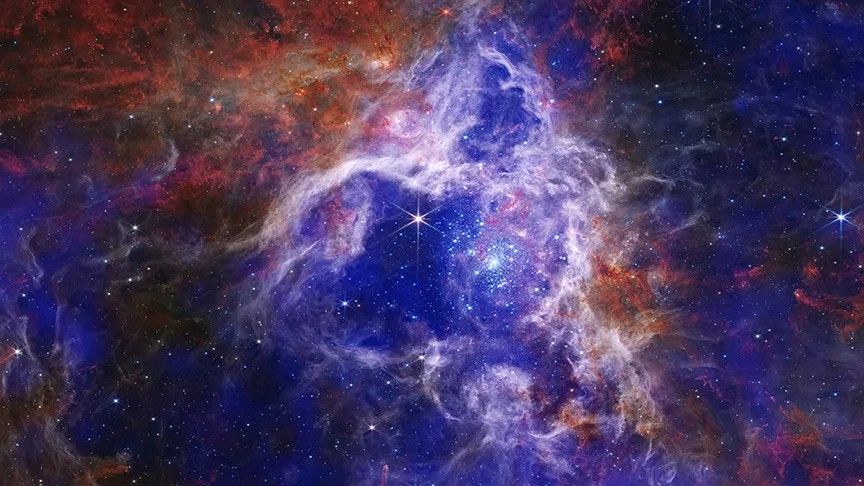To commemorate the 25th anniversary of NASA’s Chandra X-ray Observatory, scientists have rereleased new “sonified” images of nearby objects, including the supernova remnant Cassiopeia A and 30 Doradus, one of the largest and brightest regions of star formation close to the Milky Way.
The new sonified images convert visual data captured by Chandra over the last quarter century into sound, enhancing our understanding and analysis of complex X-ray data, in addition to making them more accessible to a wider range of people, in order to provide a complementary perspective to visual methods.
“Sonification is a process that translates astronomical data into sound, similar to how digital data are more routinely turned into images,” wrote the NASA team in a statement. “This translation process preserves the science of the data from its original digital state but provides an alternative pathway to experiencing the data.”

The first image is of Cassiopeia A (Cas A) and includes compiled data from Chandra as well as NASA’s James Webb, Hubble, and retired Spitzer space telescopes. Located 11,000 light-years away from Earth, is all that remains after the collapse and explosion of a massive star that was first visible in our night sky almost 300 years ago.
Chandra was the first to identify the neutron star at the image’s center, which formed following the supernova, and is the youngest neutron star to be discovered in the Milky Way. Chandra also revealed swirls of debris that expanded outward into space.
The sonified “image” was created moving outwards from the neutron star at the center, marked by a triangle sound, and moves outward to encompass the rest of the remnant where brighter areas are translated into louder volume and high pitch sounds.
Chandra’s X-ray data was mapped onto modified piano sounds, while infrared (IR) data gathered by Webb and Spitzer were translated into strings and brass. Stars identified by Hubble are portrayed by small cymbals called cortales — all coming together to create an otherworldly arrangement.
The second image to receive this treatment is of the star forming region 30 Doradus, also known as the Tarantula Nebula. This region provides the perfect setting for astronomers to study and understand how stars like our own sun form and evolve.
“This sonification again combines X-rays from Chandra with infrared data from Webb,” wrote the team. The scan in this image moves left to right, with volume again corresponding to brightness and pitch.
The nebula is filled with turbulent gases heated to extreme temperatures by cosmic winds from the massive stars in the region. These superheated gases were translated into airy synthesizer sounds. Meanwhile, the cooler gases, which will eventually coalesce to form new stars, were mapped to a range of auditory textures: Soft, low musical pitches represent these cooler regions; wind-like sounds evoke the gentle flow of gas; bright, piano-like synthesizer notes highlight the presence of very luminous stars; and a rainstick sound signifies the stars in a central cluster.
The final soundscape was created for the large spiral galaxy, NGC 6872. Spanning 522,000 light-years across, it is more than five times the size of the Milky Way galaxy and has been determined to be the largest-known spiral galaxy.
The overlaid image is captured in visible light by Hubble and contains a smaller spiral galaxy in its upper left corner, which is slowly being drawn toward NGC 6872. The scan moves clockwise through this image, with Chandra’s X-rays, represented as a wind-like sound, revealing the superheated gas that permeates the galaxies.
Compact X-ray sources from distant galaxies chirp like cosmic birds in this sonification. In the Hubble data, the core of NGC 6872 resonates with a deep, dark drone, while its blue spiral arms, bursting with new stars, sing in bright, high-pitched tones. Background galaxies produce gentle plucking sounds, and the dazzling foreground star makes a dramatic entrance with a cymbal crash.
The Chandra X-ray Observatory is an Earth-orbiting satellite that was launched in 1999. It is part of a fleet of space-based observatories, which includes the James Webb Space Telescope, the Hubble Space Telescope, the Spitzer Space Telescope, and the now deorbited Compton Gamma Ray Observatory.
Chandra observes the universe in X-ray light, a type of high-energy electromagnetic radiation that can penetrate through dense materials that visible light cannot. This unique capability allows scientists to study objects and phenomena that would otherwise remain invisible.
Transforming these cosmic images into sound is like giving the universe a new voice. It reveals hidden symphonies within the stars and galaxies, turning complex data into an immersive, auditory experience that deepens our connection with the cosmos.